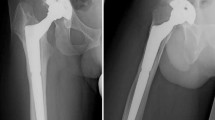Abstract
Wear volume, surface area and coefficient of friction of UHMWPE cup crosslinked with gamma radiation of 0, 50, 75, 100, 125, 150 and 200 Mrad sliding against an alumina ball were measured using a sphere-on-flat reciprocating type tribology testing machine. The effects of gamma radiation were scarcely observed in coefficient of friction. The coefficient of friction under lubricated (distilled water) and non-lubricated testing conditions was 0.08 to 0.12 and 0.20 to 0.25, respectively. The wear volume of UHMWPE with radiation of 50 Mrad, 75 to 150 Mrad, and 200 Mrad was 70 to 80%, 18 to 25%, and 12 to 15%, respectively, in comparison to non-irradiated specimens. Elongation and tensile strength of UHMWPE with radiation of 100 Mrad decreased to 6%, and 50% of that without radiation, respectively. The hardness increased with increase of the radiation dose. From several kinds of tribological findings, mechanical strength tests, and studies of long-term clinical findings, it is concluded that approximately 200 Mrad is the optimum dose of gamma radiation for clinical use in total hip prostheses.
Similar content being viewed by others

References
J. CHARNLEY, Brit. Med. J. 1 (1960) 821.
B. M. WROBLEWSKI, Clin. Orthop. 211 (1986) 30.
H. OONISHI, H. IGAKI and Y. TAKAYAMA, 3rd World Biomaterials Congress, Transactions, April 21–25, Kyoto, Japan, 1988, p. 588.
Idem., MRS International Meeting on Advanced Materials, Vol. 1, Materials Research Society, 1989, pp. 351–356.
H. OONISHI and E. TSUJI, “Clinical implant materials, advances in biomaterials”, Vol. 9 (Elsevier, Amsterdam, 1990) pp. 379–384.
H. OONISHI, Y. TAKAYAMA and E. TSUJI, Radiat. Phys. Chem. 39 (1992) 495.
Idem., Surface ModiÞcation Technol. V (1992) 101.
H. OONISHI, H. IGAKI and Y. TAKAYAMA, “Bioceramics”, Vol. 1 (Ishiyaku Euro-American, Tokyo/St. Louis, 1989) pp. 272–277.
H. OONISHI, Orthopaedic surgery and Traumatology, 38, 11 (1995) 1255–1264 (Japanese) (Kamehara Publisher).
H. OONISHI, A. FUJISAWA, M. OKA, Y. IKADA and K. IKEUCHI, Report in Japanese ArtiÞcial Organ Welfare Foundation, (16) 3-1-5, 1995 (Japanese), pp. 204–213
Author information
Authors and Affiliations
Rights and permissions
About this article
Cite this article
OONISHI, H., KUNO, M., TSUJI, E. et al. The optimum dose of gamma radiation–heavy doses to low wear polyethylene in total hip prostheses. Journal of Materials Science: Materials in Medicine 8, 11–18 (1997). https://doi.org/10.1023/A:1018582027349
Issue Date:
DOI: https://doi.org/10.1023/A:1018582027349



